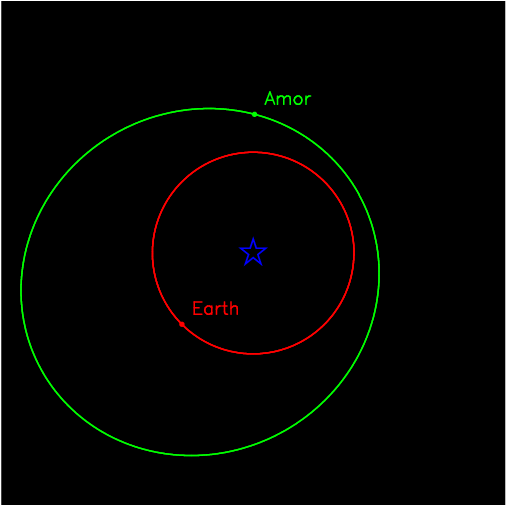
NEO sub-population with perihelion distance larger than 1 AU and smaller than 1.3 AU
absolute
magnitude (H):
Measure of the intrinsic brightness
of the object. The fainter is the body, the higher is H. Once the
albedo
is known, H is related to the size of the object.
albedo:
Measure of the reflectivity
of the object. It is defined as the fraction of the received light that
is reflected into space. Bodies made of carbon-rich material are dark,
and thus have small albedos (~6%), while stony bodies and metallic bodies,
have moderate (~20%) and large (~40%) albedos, respectively.
 |
Amors:
NEO sub-population with perihelion distance larger than 1 AU and smaller than 1.3 AU |
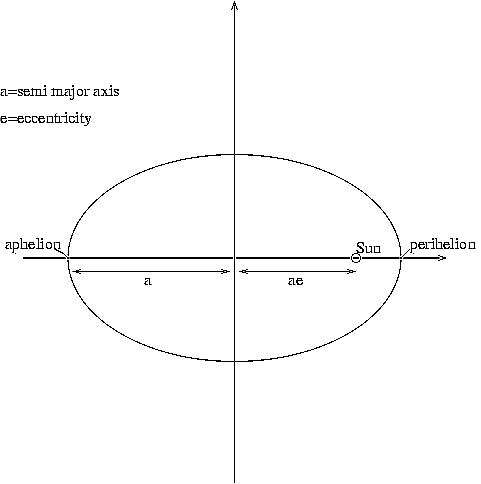 |
aphelion distance (Q):
Maximal distance from the Sun that the object reaches along its elliptic orbit. |
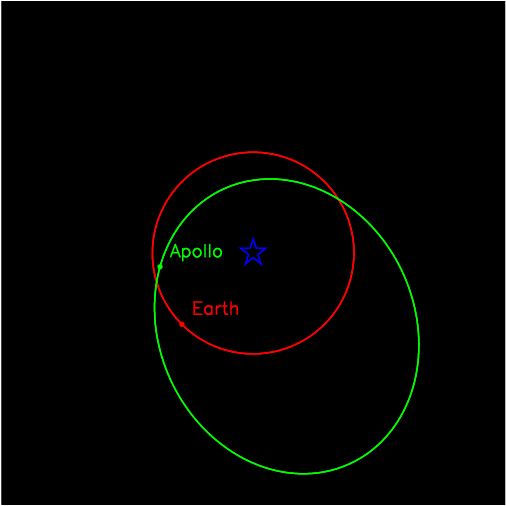 |
Apollos:
NEO sub-population with perihelion distance smaller than 1 AU and semi major axis larger than 1 AU. |
apparent
magnitude (V):
Measure of the brightness of
the body seen by the observer. The fainter appears the body, the higher
is V. Given the absolute magnitude of the object, the apparent magnitude
depends on the position of the object relative to the Sun and the observer.
 |
asteroids:
Small bodies of rocky composition. Unlike comets, they do not liberate gasses and dust due to the solar heat |
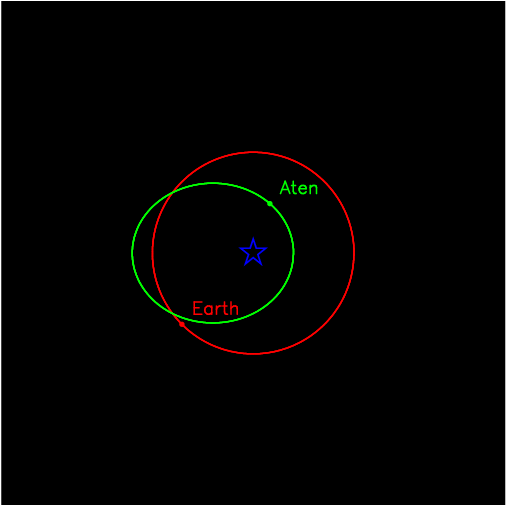 |
Atens:
NEO sub-population with semi major axis smaller than 1 AU and aphelion distance larger than 0.983 AU. |
Astronomical
Unit (AU):
Average distance of the Earth
from the Sun. Approximately equal to 150 million kilometres.
bias:
Correction factor that relates
the real population to the observed population. It is typically a function
of the body's orbital elements a,e,i
and
absolute
magnitude H.
Once the bias B is known, in principle
the real number of objects
N can be estimated as N(a,e,i,H)=n(a,e,i,H)/B(a,e,i,H),
where
n
is the number of objects detected by the survey. The problem, however,
is resolution; even a coarse binning in the 4-dimensional orbital-magnitude
space of the bias function and of the observed distribution requires the
use of about 10,000 cells. The total number of NEOs
detected by the most efficient surveys is a few hundreds. Thus, n
is zero in the vast majority of the cells, and it is equal to 1 in most
other cells; cells with n>1 are very rare. The de-biasing of the
NEO population is therefore severely affected by small number statistics.
This is the reason that motivated our innovative methodology.
bulk
density:
Ratio between the mass of a
body and its volume.
celestial
mechanics:
Science that studies the motion
of bodies in space.
close
encounter:
The passage of a body in the
vicinity of a planet, that causes the deflection of the body's trajectory.
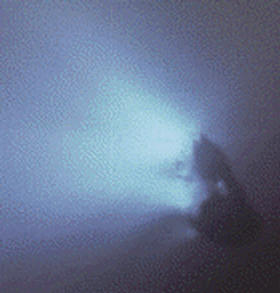 |
comets:
Small bodies of icy compositions. When heated by the Sun in the inner solar system they liberate gasses and dust, which give them the typical cometary appearance. Nevertheless, it is believed that old comets, which have lost most or all of their volatiles, may become dormant, and assume an asteroidal appearance. |
detection
efficiency:
The fraction between the number
of objects detected by the survey and that of the objects in the survey's
field of view. The detection efficiency is never 100%, because the objects
can overlap with stars or galaxies or, if they are faint, be confused within
the noise of the image background.
| eccentricity (e):
Measure of the ellipticity of the orbit. A circular orbit has e=0 while a segment has e=1. |
|
 |
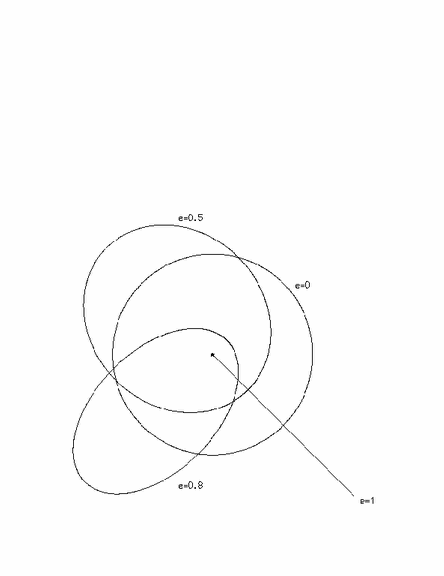 |
ecliptic:
The curve defined by the apparent
motion of the Sun in the sky.
ecliptic
latitude & longitude:
System of coordinates that define
the position of an object in the sky. The latitude measures the distance
of the object from the ecliptic while the longitude
measures the position of the projection of the object on the ecliptic.
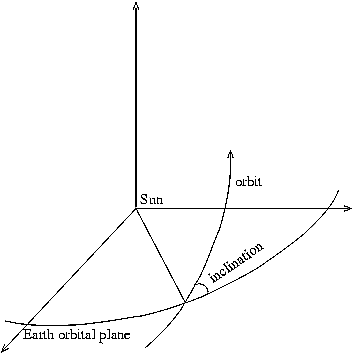 |
inclination (i):
Angle between the plane that contains the orbit of the body and the orbital plane of the Earth. |
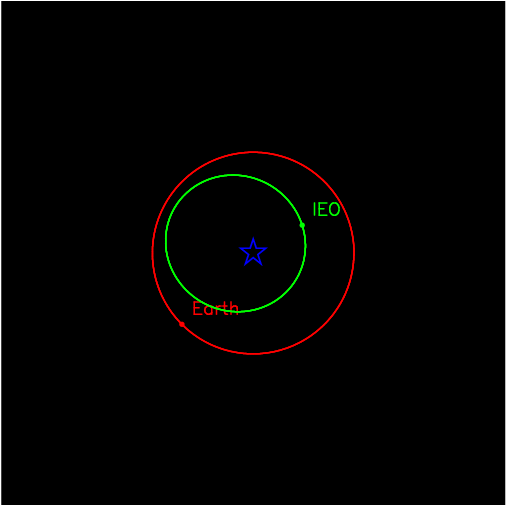 |
Inner Earth Objects (IEO):
Objects with aphelion distance smaller than the perihelion distance of the Earth. Consequently, these objects are always inside the Earth's orbit. This makes them particularly difficult to be discovered from the ground, and in fact no object of this category has yet been found. |
Intermediate
Mars-Crossing (IMC) population:
Asteroid
population with perihelion distance
larger than 1.3 AU, semi
major axis between 2.06 and 2.8 AU, inclination
below the location of the nu6 resonance, and crossing
the orbit of Mars during a secular oscillation cycle of their eccentricity.
Many asteroids in the IMC population become NEOs on
a timescale of several tens of million years. Nevertheless the IMC population
does not shrink in number, because it is directly replenished by an extensive
network of resonances that continuously transport asteroids from the main
belt into the IMC region.
Jupiter Family
Comets (JFC):
Population of short periodic
comets
with low inclination, on Jupiter-crossing
or quasi-crossing orbits. They are believed to come from the populations
situated beyond the orbit of Neptune: the Kuiper belt and the Scattered
disk.
limiting
magnitude:
The apparent
magnitude at which the detection efficiency
drops to 50% of the detector's peak efficiency.
longitude
of perihelion:
Orientation of the perihelion
of the orbit.
main
belt:
Region between Mars and Jupiter
inhabited by a large number of asteroids.
megaton
TNT (MT):
Unit of measure for the energy
of an explosion. The
Hiroshima atomic bomb liberated an energy of 0.015 MT.
Minimal Orbital
Intersection Distance (MOID);
The MOID is the minimal distance between the orbits
of two objects.
nu6 resonance:
Resonance that occurs when the
precession
frequency of the asteroid's
longitude
of perihelion is equal to the sixth secular frequency of the planetary
system. The latter is related to the mean precession frequency of Saturn's
longitude of perihelion, but it is also relevant in the secular oscillation
of the
eccentricity of Jupiter.
Near Earth
Objects (NEO):
Asteroids
and comets on orbits with perihelion
distance q<1.3 AU
and aphelion
distance Q>0.983 AU. They are subdivided in the Apollo,
Amor
and Aten subclasses. For simplicity in the text, under
the name NEO we also include the population of Inner Earth
Objects.
opposition:
Point in the sky that is opposite
to the apparent position of the Sun.
Outer Belt (OB)
population:
Asteroids
with semi major axis larger than 2.8 AU
and perihelion distance smaller than
2.4 AU. Like the asteroids in the IMC population, also
bodies in the OB population become NEOs on a timescale
of several tens of million years.
 |
perihelion distance (q):
Minimal distance from the Sun that the object reaches along its elliptic orbit. |
Potentially
Hazardous Objects (PHOs):
NEOs with
MOID<0.05
AU
and
H<22. These bodies pass
sufficiently close to the Earth orbit and are big enough to constitute
a potential danger. In fact, planetary perturbations can decrease in about
a century the MOID from 0.05 AU to less than the Earth's radius, at which
point a collision with our planet can occur.
precession:
Slow rotation of an angle that
defines the orientation of the orbit in space.
 |
semi major axis (a):
Measure of the size of the orbit (mean between perihelion and aphelion distance). It is related to the orbital period by the third law of Kepler (the cube of the semi major axis is proportional to the square of the period). |
Spaceguard
goal:
The discovery and orbital determination
of 90% of the H<18 NEOs
within 2008.
steady
state:
State reached when the number
of new elements entering the population equals the number of elements
eliminated from the population in the same timespan.Hence, though individuals
evolve, the population as a whole remains the same. An example of steady
state is that of a society with zero growth, where the number of children
born in the year is equal to the number of individuals that have passed
away. For the NEO population, the existence of a steady
state is suggested by the observation that the cratering rate of the Moon
has been roughly constant over the last 3.5 billion years.
taxonomic
class:
Group of asteroids
with similar spectral properties of the reflected light. It is generally
accepted that asteroids of the same taxonomic class share a similar chemical
composition. The asteroids of the C taxonomic class should be similar to
carbonaceous chondritic meteorites, while the asteroids of the S taxonomic
class should be similar to ordinary chondritic meteorites.
terrestrial
planet:
A planet of rocky composition,
like Mercury, Venus, the Earth or Mars
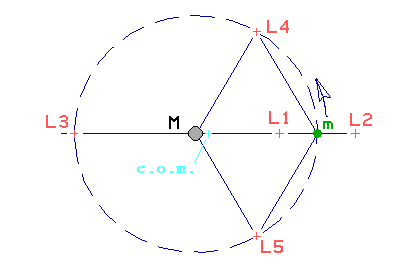 |
Trojans:
Small bodies having, on average, the same orbital period of a planet. They are located around the so-called L4 and L5 Lagrange equilibrium points. The latter form, with the Sun and the planet, two equilateral triangles. |
3:1 resonance:
Resonance that occurs at 2.5
AU,
where the orbital period of the
asteroid is one
third of that of Jupiter.